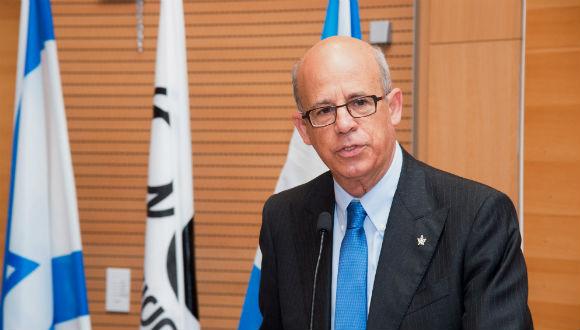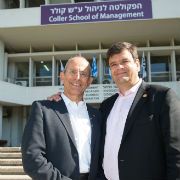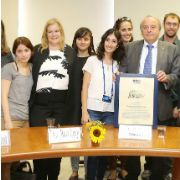BOG 2016: Report by Prof. Joseph Klafter
“This year, one of our astronomers discovered a million young stars that no one knew about before. This cluster of stars shines one billion times brighter than our own sun, but still – it had never been seen before. That’s because the stars are hidden by a hot cloud of gases and particles – or in other words, by dust. Cosmic dust.
“Governors, friends and colleagues, our mission at the University is to sweep the dust away and find the stars. We encourage our researchers and students to unveil hidden secrets. We expect them to illuminate our world with science and scholarship. We also want to sweep out the dust mice of conventional wisdom. A research institution has to rethink itself constantly; it has to welcome disruption. So this year, our 60th, we’re celebrating six decades of pursuit and discovery, but we’re also planning how Tel Aviv University will evolve and grow further.
“Before I sketch out achievements and plans, I would like to introduce the new Rector of Tel Aviv University, Prof. Yaron Oz, who assumed the role this year after Prof. Aron Shai completed his term. Yaron is a close colleague of mine; prior to his selection as Rector he was the Dean of the Raymond and Beverly Sackler Faculty of Exact Sciences, and before that, he was the Head of the Raymond and Beverly Sackler School of Physics and Astronomy.
“I’ll be dividing my report into two parts: Historic milestones and new initiatives.
“Early on in Tel Aviv University’s history, in the 1960s and early ‘70s, the organization of the University was led by the first President, Dr. George S. Wise. By 1972, the University reached its present structure of 9 faculties. There were 12,000 students at the time. Today, those 9 faculties have grown to include 125 schools and departments, with a student body of almost 30,000.
“Now, under this structure, the University did marvelous things. But it became increasingly clear that this abundance of departments was getting unmanageable. And while inertia may be a law of nature, it’s not recommended for organizational health. We realized that we needed to look inward, ask the rigorous questions, see what needed to be changed, and then make the leap. After a comprehensive review of operations by the consulting company Shaldor, headed by Sami Friedrich, the University embarked on an academic reorganization.
“After a process of about two years, led by Prof. Ariel Porat, who wrote an impeccable proposal, and TAU Vice President for R&D Prof. Yoav Henis, who supervised the planning, we have a restructuring blueprint that will be implemented in the year 2016-17. Instead of various small departments, everything will be organized into some 30 larger schools.
“The benefits of the reorg are manifold. We will create a critical mass of faculty members in each school; there will be more synergy across disciplines; study programs will be more diversified; course choices will become broader; standards for hiring faculty will become even higher, and we can avoid overlap; and management will become easier and more efficient. By the way, other universities are trying to do this, and not just in Israel, but they have not succeeded.
“It really is a big leap and, for me, a historic moment.
“Another historic development involves our branding. We did some market research and discovered something interesting: We are an Israeli super-brand that had never been branded! In all the surveys, when respondents were asked to name the first Israeli university that came to mind, over 80 percent said, "Tel Aviv University." This is very nice. But it isn't enough to prevail in an increasingly competitive academic market. Also, over the years, our Governors and Friends have asked for better branding tools to work with in an increasingly competitive philanthropic market.
“So in the last year and a half, the University underwent a branding process that took into account all stakeholders – faculty and staff, students, supporters, donors, and the general public. We thought hard about our cultural DNA and how to communicate it afresh. And I have to say, this was rewarding, but not simple. Indeed, both major steps I've been describing – the departmental restructuring and the branding – have not been simple.
“Now, moving on to academic initiatives, I’d like to highlight our growing Data Science Center. Did you know that 90 percent of the oceans of data in the world was created in just the last year alone? Someone has to make sense of all this information, and we’ve got a large interdisciplinary team on the case.
“Prominent additions to the campus that we’re dedicating at this year’s Board meeting include the Coller School of Management – the $50 million lead project in TAU’s new Capital Campaign; Steve Tisch School of Film and Television launched last year; BLAVATNIK CENTER for Drug Discovery; and Boris Mints Institute for Strategic Policy Solutions to Global Challenges. Other new major projects are the Dan David Center for “Human Evolution and Biohistory Research; Raymond and Beverly Sackler Computational Center for Materials Science; Photonics Center; and City Center for urban studies, which includes the Smart Transportation Accelerator at the Porter School of Environmental Studies. We are very pleased, also, to announce the renewal and expansion of the Sagol School of Neuroscience.
“In the international sphere, the University is flourishing. We've signed at least a dozen new cooperation agreements with foreign universities this year. This is in great part due to the efforts of Vice President Raanan Rein, who is in charge of global academic ties.
“Regarding faculty recruitment, our multi-year investment has yielded results. Total research funding raised by our faculty members and Ramot, the University’s technology transfer arm, is $200 million. In Europe we've done spectacularly. Funding support from the European Research Council (ERC) totals $48 million. TAU leads Israel in the number of ERC-funded projects and ranks 3rd in Europe for starter grants for young faculty.

“A boost to recruitment can come from donors. Examples include new faculty in Yiddish Studies thanks to the Naomi Prawer Kadar Foundation; and the Porter Foundation joint appointments. Tel Aviv University is also a grateful participant in a major American-Israeli initiative called the Zuckerman STEM Leadership Program. It’s the brainchild of Mr. Mort Zuckerman, who is receiving TAU’s Dr. George S. Wise Medal. The program will bring home Israeli researchers in the sciences to the four leading Israeli universities, including TAU. In addition, under the program, American post-docs will receive generous fellowships to conduct their research here. It’s a wonderful program that stands to greatly strengthen American-Israeli ties.
“Before I move onto campus physical development, I would like to make special mention of two programs dear to my heart. They greatly contribute to creating opportunities at TAU and in Israel, and I was greatly moved at the generosity of our donors in supporting them. The first is the Nissim and Rina Levy Periphery Scholarship Fund, and the second is the Kadar Scholarships for Women in Business and Entrepreneurship.
“Last year I presented a map of new buildings springing up like mushrooms across the campus. Meanwhile, many of those projects have gained shape – thanks to the tremendous efforts of the TAU Director-General, Mordehai Kohn, and his team. The Steinhardt Museum of Natural History, Israel National Center for Biodiversity Studies, is slated to open next year. Ground has been broken and construction has begun on the Check Point Building. The cornerstone was laid for a new building in the Life Sciences. Plans were finalized for the Lorry I. Lokey Graduate Center, and an international architectural competition was completed for the new building for our Center for Nanoscience and Nanotechnology.

Rendering for the Nanoscience and Nanotechnology Building

Rendering for the Lorry I. Lokey Graduate Center
“All this new space, along with other planned buildings, will enable more content. More laboratories, more teaching halls and classrooms, more areas for students to study and relax. More outstanding research, more international collaborations, more incubators and accelerators for startups. This is a massive stamp of confidence by our donors in the University and its potential, and a substantial boost to our $1 billion capital campaign. Warm thanks go to the Vice President for Resource Development, Amos Elad, and his staff, for their fundraising endeavors.
“I’m excited about the University’s prospects. I’m grateful for the 60 years of support that helped bring us to this juncture. Some of you have been with the University since the beginning through your families. Others of you are newer to the organization. All of you, by coming to the Board of Governors meeting, are showing your commitment to us and to Israel.
“I look forward to working with you all: our Governors and Friends; our leadership and professionals across the globe; the TAU Management, faculty and administration; and of course my dedicated personal staff. Together we will succeed in fulfilling Tel Aviv University’s potential.”





